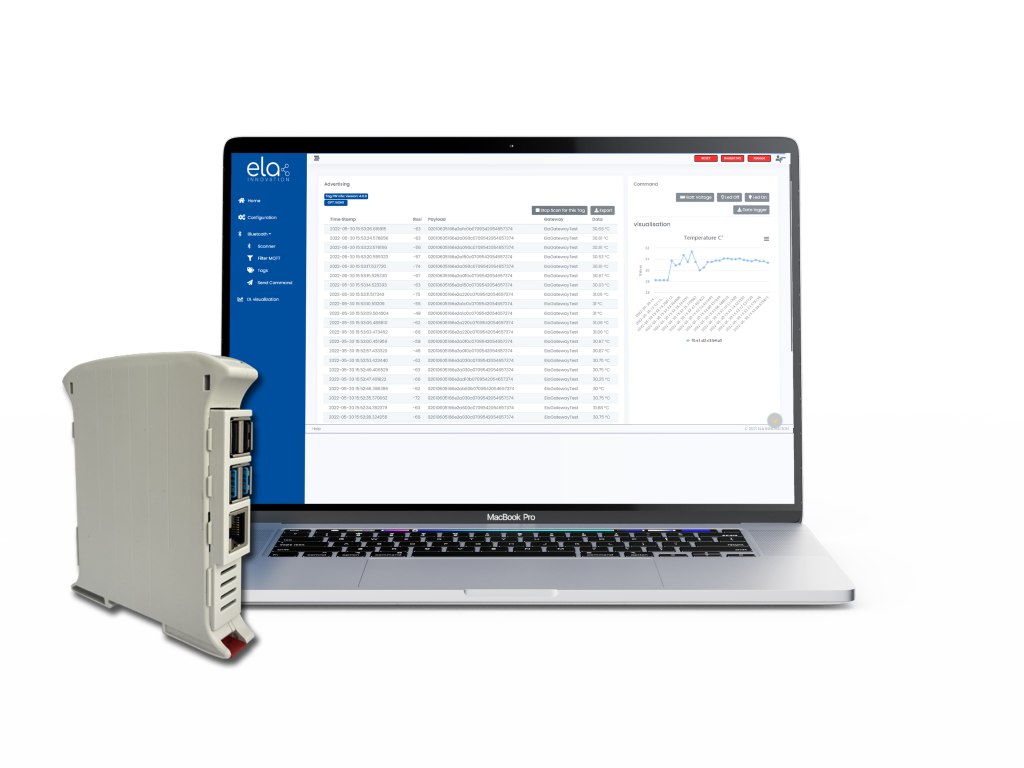Bluetooth Low Energy (BLE)
Would you like to integrate BLE technology into your IoT solutions? We explain how this standard wireless communication protocol works.

What is Bluetooth Low Energy?
Bluetooth Low Energy (BLE), also known as Bluetooth smart, is a wireless communication technology designed to create private networks (PANs), enabling connections to be established between connected objects and gateways (smartphone, PC, access point) to collect a wide range of data.
This variant of “classic” Bluetooth has been designed to offer the lowest possible energy consumption, which has greatly contributed to its development in the industrial connected object market. Among other things, this technical specificity considerably extends the autonomy of connected objects by reducing their activity time.
Because of the way it works, Bluetooth Low Energy is better suited to industrial applications than “conventional” Bluetooth. Many industrial use cases do not require high transmission recurrence, or the transmission of heavy or complex information.
Embedded in wireless sensors and beacons, this open communication protocol will facilitate the collection of data such as temperature, ambient humidity, door opening detection, movement or even an identification number.
Discover our range of Bluetooth beacons and industrial sensors.
Discover our range of Bluetooth beacons and industrial sensors.
Bluetooth beacons Vs Bluetooth sensors
To collect data using Bluetooth Low Energy technology, manufacturers rely on network infrastructures in which connected objects such as beacons or sensors are used.
Bluetooth Beacon
A Bluetooth beacon is a small wireless beacon, similar to a badge, whose role is to emit a unique identification number called a UID (Unique Identifier) at regular intervals. BLE beacons can be used in a wide range of applications involving identification, automatic inventory and tracking:
Bluetooth sensor
An industrial Bluetooth sensor is a wireless sensor for measuring and collecting a wide range of environmental data. A Bluetooth sensor can be used in a wide range of sectors to digitalize business processes, improving performance and safety:
Automatic inventory of pallets, spare parts, etc.
Tracking equipment on a construction site, in a warehouse, in a vehicle…
Identification of drivers, passengers,…
Identification of trailers, tippers, etc.
Building and site access control,…
Protecting goods and equipment against theft
Predictive and preventive maintenance
Cold chain traceability
Workspace occupancy measurement
Managing building energy consumption
Bluetooth Beacon
A Bluetooth beacon is a small wireless beacon, similar to a badge, whose role is to emit a unique identification number called a UUID (Universal Unique Identifier) at regular intervals. BLE beacons can be used in a wide range of applications involving identification, automatic inventory and tracking:
Identification of trailers, tippers, etc.
Building and site access control,…
Identification of drivers, passengers,…
Tracking equipment on a construction site, in a warehouse, in a vehicle…
Automatic inventory of pallets, spare parts, etc.
Bluetooth sensor
An industrial Bluetooth sensor is a wireless sensor for measuring and collecting a wide range of environmental data. A Bluetooth sensor can be used in a wide range of sectors to digitalize business processes and improve performance and safety:
Protecting goods and equipment against theft
Predictive and preventive maintenance
Workspace occupancy measurement
Cold chain traceability
Managing building energy consumption
Why choose BLE?
If you’re looking for a wireless communication technology that offers range flexibility while maintaining low power consumption, BLE is the ideal solution for your IoT needs.
Reduced energy consumption
If you’re looking for a wireless communication technology that offers range flexibility while maintaining low power consumption, BLE is the ideal solution for your IoT needs.
Adaptive range
BLE offers a flexible range that can be adjusted according to the needs of the application. You can have a range from a few meters to several tens of meters, allowing it to be adapted to specific use scenarios.
Connectivity and interoperability
BLE has numerous standard profiles that define how devices should communicate for specific use cases, making it compatible with a wide range of devices, from smartphones to IoT sensors, facilitating interoperability between all devices.
Enhanced safety
BLE security protocols ensure that your data is protected during transmission. You can be confident of the confidentiality of your information, even in sensitive environments.
How does Bluetooth Low Energy work?
Bluetooth Low Energy technology enables bidirectional data exchange using UHF radio waves, and operates in the ISM frequency range from 2.400 GHz to 2.483 GHz. 40 channels spaced 2 MHz apart are allocated to BLE to enable devices to communicate.
BLE has different types of connection, and any BLE-connected object can have up to 4 different functions:
- Broadcaster : its role is to regularly transmit data to a device, but it does not accept any incoming connections. It can also act as a server.
- The observer : in this context, the object can only listen to and interpret data sent by a broadcaster. It cannot send connections to the server.
- Central : receives and processes files sent by a broadcaster.
- The peripheral: Takes over connections from the central unit, before transferring files to it.

Do you have an IoT project?
Our experts can advise and support you in your choice of Bluetooth sensors and beacons.
Do you have an IoT project?
Our experts can advise and support you in your choice of Bluetooth sensors and beacons.
What does a BLE network infrastructure consist of?
A BLE network infrastructure will be based on a set of beacons and/or Bluetooth sensors, a gateway (access point, smartphone, PC, tracker, etc.), a back-end (server/cloud) and a business application.

Connected objects will transmit their ID numbers and/or sensor data at regular intervals. The BLE gateway will continuously scan and listen to its environment, detecting beacons and IoT sensors within its perimeter. It will collect the information and transfer it to the customer’s server/cloud, either via Ethernet, WiFi or 4G. On the back-end, raw data is stored, processed and analyzed.
Once the data has been deciphered, it can be visualized on the business application in the form of a history, graph or map. Commands can also be sent to beacons and sensors from the business application, such as the LED ON/OFF functionality.
What is the range of the BLE?
Bluetooth Low Energy (BLE) signal range is one of the key features of this wireless communication technology. Range determines the maximum distance over which a BLE device can establish a connection and communicate with another device, such as a smartphone, sensor or accessory. Here are some important points to understand about BLE signal range:
Typical range
BLE signal range varies according to several factors, including the device’s power class, the environment, obstacles and radio interference. In general, however, typical BLE range is between 10 and 100 meters. At short distances, the range can be very short (a few meters), while at long distances, it can reach 100 meters or more.
Power classes
BLE devices are generally classified into three power categories: Class 1, Class 2 and Class 3. Class 1 offers the maximum range, up to over 100 meters. Class 2 is common for BLE devices such as smartphones, offering a typical range of around 10 meters. Class 3 is rare, offering a range limited to a few meters.
Environment and obstacles
The environment has a significant impact on the range of BLE. Physical obstacles, such as walls, furniture and metal elements, can attenuate the signal and reduce range. Open outdoor environments generally provide greater range than cluttered indoor environments.
Radio interference
Interference from other wireless devices or Wi-Fi networks can disrupt the BLE range. In environments where numerous wireless signal sources coexist, range may be affected.
Specific implementation
Actual range may vary depending on how BLE is implemented in a particular device. Some manufacturers integrate more powerful antennas to increase range, while others may prioritize low power consumption at the expense of range.
Applications
BLE’s range is suitable for many IoT applications, including personal monitoring, proximity sensors, object trackers, wearable devices, keyless locking systems, and many others.
Difference between Bluetooth Low Energy and classic Bluetooth?
Bluetooth Low Energy (BLE) is a variant of Bluetooth Classic that has been part of the standard since version v4.0 was published in 2010. These two wireless communication protocols share the same origin, but their characteristics, functionalities and fields of application are very different.
Energy consumption
Because of its higher power consumption, conventional Bluetooth is commonly used on devices powered by a constant energy source, such as electrical outlets or larger batteries.
Bluetooth Low Energy, as its name suggests, is designed to be energy-efficient. It’s ideal for applications requiring long battery life, such as sensors, tracking devices and wearables.
Latency
Classic Bluetooth is designed for high-speed data transfer. It’s ideal for transmitting large files, such as streaming music and high-quality voice. However, it does require higher power consumption.
BLE is designed for small data transfers, but is effective for sending data periodically or in response to events. This makes it an ideal choice for low-speed monitoring and control.
Data transfer rate
BLE supports intermittent connections, where devices wake up, exchange data and go into standby mode to save energy. This approach is ideal for devices that don’t need a constant connection.
Classic Bluetooth, on the other hand, is often used for continuous connections, such as wireless audio streaming from a smartphone to headphones or a speaker. It is well suited to applications requiring constant data transmission.
Range
Generally speaking, the Bluetooth protocol is a proximity wireless technology. Conventional Bluetooth offers a range limited to a few meters (10 to 15m max.). Bluetooth Low Energy, on the other hand, offers a slightly longer range, reaching up to a few hundred meters in an open field.
In all cases, the environment in which Bluetooth beacons and sensors are used will have a strong impact on range. Indeed, their performance will be degraded by obstacles such as walls or metal beams.
In short, the main difference lies in power consumption and target applications. Conventional Bluetooth is suited to applications requiring continuous, high-speed data transmission, while BLE is designed for applications with low power consumption and sporadic data transfer. The choice between the two depends on your specific wireless communication needs.
Alternative technologies to BLE?

BLE vs Wirepas Mesh
Wirepas technology uses a mesh network, where each connected device can act as a relay for data, creating a self-organizing, resilient network. This allows great flexibility in network configuration. But unlike BLE, Wirepas is not standardized and open, focusing primarily on local connectivity, which means it is suited to applications requiring short-range communications in specific environments. For applications such as indoor tracking of people or tools, Wirepas technology will offer greater precision and responsiveness than BLE.
BLE vs Quuppa
Quuppa technology is based on an infrastructure consisting of wired 360° antennas fixed at height and location beacons called “tags” embedded in the objects or people to be loalised. The main difference between BLE and Quuppa technology lies in the method used to calculate position. Quuppa is based on the AoA (Angle of Arrival) method, offering extremely accurate real-time localization (RTLS) (<1m), whereas BLE is based on the strength of the RSSI signal, enabling localization to within a few meters. The network infrastructure required to achieve this level of precision with Quuppa technology, however, may entail higher acquisition costs than with BLE. The choice between the two technologies will depend on the specific needs of the application and the levels of accuracy required.

BLE vs Wi-Fi
The choice between BLE and Wi-Fi in the IoT field depends on the specific needs of the application. BLE is ideal for low-power, short-range devices, while Wi-Fi is better suited to applications requiring higher data rates over greater distances. It is also possible to use these two technologies in a complementary way to meet the specific requirements of an IoT project. Bluetooth Low Energy technology is interoperable with existing Wi-Fi networks, making it easy to integrate, particularly for smart-building applications.